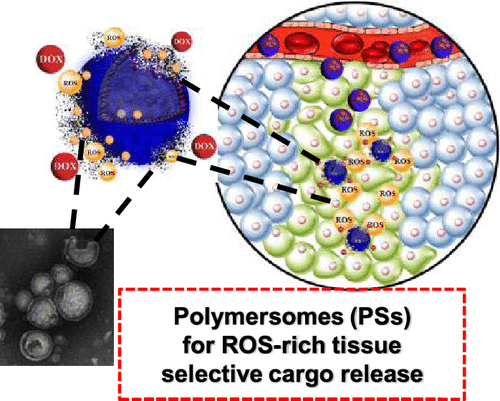当前位置:
X-MOL 学术
›
Biomacromolecules
›
论文详情
Our official English website, www.x-mol.net, welcomes your
feedback! (Note: you will need to create a separate account there.)
Reactive Oxygen Species (ROS)-Responsive Polymersomes with Site-Specific Chemotherapeutic Delivery into Tumors via Spacer Design Chemistry.
Biomacromolecules ( IF 5.5 ) Pub Date : 2020-02-21 , DOI: 10.1021/acs.biomac.9b01748 Eliézer Jäger 1 , Vladimir Sincari 1 , Lindomar J C Albuquerque 2 , Alessandro Jäger 1 , Jana Humajova 3 , Jan Kucka 1 , Jan Pankrac 4 , Petr Paral 4 , Tomas Heizer 4 , Olga Janouskova 1 , Rafał Konefał 1 , Ewa Pavlova 1 , Ondrej Sedlacek 1 , Fernando C Giacomelli 2 , Pavla Pouckova 3 , Ludek Sefc 4 , Petr Stepanek 1 , Martin Hruby 1
Biomacromolecules ( IF 5.5 ) Pub Date : 2020-02-21 , DOI: 10.1021/acs.biomac.9b01748 Eliézer Jäger 1 , Vladimir Sincari 1 , Lindomar J C Albuquerque 2 , Alessandro Jäger 1 , Jana Humajova 3 , Jan Kucka 1 , Jan Pankrac 4 , Petr Paral 4 , Tomas Heizer 4 , Olga Janouskova 1 , Rafał Konefał 1 , Ewa Pavlova 1 , Ondrej Sedlacek 1 , Fernando C Giacomelli 2 , Pavla Pouckova 3 , Ludek Sefc 4 , Petr Stepanek 1 , Martin Hruby 1
Affiliation

|
The lack of cellular and tissue specificity in conventional chemotherapies along with the generation of a complex tumor microenvironment (TME) limit the dosage of active agents that reaches tumor sites thereby resulting in ineffective responses and side effects. Therefore, the development of selective TME responsive nanomedicines is of due relevance towards successful chemotherapies, albeit challenging. In this framework, we have synthesized novel, ready-to-use ROS-responsive amphiphilic block copolymers (BCs) with two different spacer chemistry designs to connect a hydrophobic boronic ester-based ROS sensor into the polymer backbone. Hydrodynamic flow focusing nanoprecipitation microfluidics (MF) was used in the preparation of well-defined ROS-responsive PSs there were further characterized by a combo of techniques (1H NMR, DLS, SLS, TEM and cryo-TEM). The reaction with hydrogen peroxide releases an amphiphilic phenol or a hydrophilic carboxylic acid which impacts polymersome (PS) stability and cargo release. Therefore, the importance of the spacer chemistry in BCs deprotection and PSs stability and cargo release is herein highlighted. We have also evaluated the impact of spacer chemistry on PS-specific release of the chemotherapeutic drug doxorubicin (DOX) into tumors in vitro and in vivo. We demonstrate that by spacer chemistry design one can enhance the efficacy of DOX treatments (decrease in tumor growth and prolonged animal survival) in mice bearing EL4 T cell lymphoma. Side effects (weight loss and cardiotoxicity) were also reduced compared to free DOX administration highlighting the potential of the well-defined ROS-responsive PSs as TME selective nanomedicines. The PSs could also find applications in other environments with high ROS-levels, such as, for instance, chronic inflammations, aging, diabetes, cardiovascular diseases and obesity.
中文翻译:

通过间隔物设计化学将特定部位的化学疗法递送到肿瘤中的反应性氧(ROS)反应性聚合物小体。
传统化学疗法中缺乏细胞和组织特异性以及复杂肿瘤微环境(TME)的产生限制了到达肿瘤部位的活性剂的剂量,从而导致无效的反应和副作用。因此,尽管具有挑战性,选择性TME反应性纳米药物的开发与成功的化学疗法具有适当的关系。在此框架中,我们合成了具有两种不同间隔基化学设计的新型,即用型ROS响应型两亲嵌段共聚物(BCs),以将基于疏水性硼酸酯的ROS传感器连接到聚合物骨架中。流体动力学聚焦纳米沉淀微流控技术(MF)用于制备定义明确的ROS响应PS,并通过一系列技术(1H NMR,DLS,SLS,TEM和冷冻TEM)。与过氧化氢的反应释放出两亲酚或亲水性羧酸,这会影响聚合物囊泡(PS)的稳定性和货物的释放。因此,本文突出了间隔基化学在BCs脱保护以及PSs稳定性和货物释放中的重要性。我们还评估了间隔化学对体外和体内PS特异性释放化疗药物阿霉素(DOX)进入肿瘤的影响。我们证明,通过间隔化学设计,可以在携带EL4 T细胞淋巴瘤的小鼠中增强DOX治疗的功效(降低肿瘤生长和延长动物存活时间)。与免费DOX给药相比,副作用(体重减轻和心脏毒性)也有所降低,突出了明确定义的ROS反应PS作为TME选择性纳米药物的潜力。
更新日期:2020-02-21
中文翻译:

通过间隔物设计化学将特定部位的化学疗法递送到肿瘤中的反应性氧(ROS)反应性聚合物小体。
传统化学疗法中缺乏细胞和组织特异性以及复杂肿瘤微环境(TME)的产生限制了到达肿瘤部位的活性剂的剂量,从而导致无效的反应和副作用。因此,尽管具有挑战性,选择性TME反应性纳米药物的开发与成功的化学疗法具有适当的关系。在此框架中,我们合成了具有两种不同间隔基化学设计的新型,即用型ROS响应型两亲嵌段共聚物(BCs),以将基于疏水性硼酸酯的ROS传感器连接到聚合物骨架中。流体动力学聚焦纳米沉淀微流控技术(MF)用于制备定义明确的ROS响应PS,并通过一系列技术(1H NMR,DLS,SLS,TEM和冷冻TEM)。与过氧化氢的反应释放出两亲酚或亲水性羧酸,这会影响聚合物囊泡(PS)的稳定性和货物的释放。因此,本文突出了间隔基化学在BCs脱保护以及PSs稳定性和货物释放中的重要性。我们还评估了间隔化学对体外和体内PS特异性释放化疗药物阿霉素(DOX)进入肿瘤的影响。我们证明,通过间隔化学设计,可以在携带EL4 T细胞淋巴瘤的小鼠中增强DOX治疗的功效(降低肿瘤生长和延长动物存活时间)。与免费DOX给药相比,副作用(体重减轻和心脏毒性)也有所降低,突出了明确定义的ROS反应PS作为TME选择性纳米药物的潜力。





















































 京公网安备 11010802027423号
京公网安备 11010802027423号